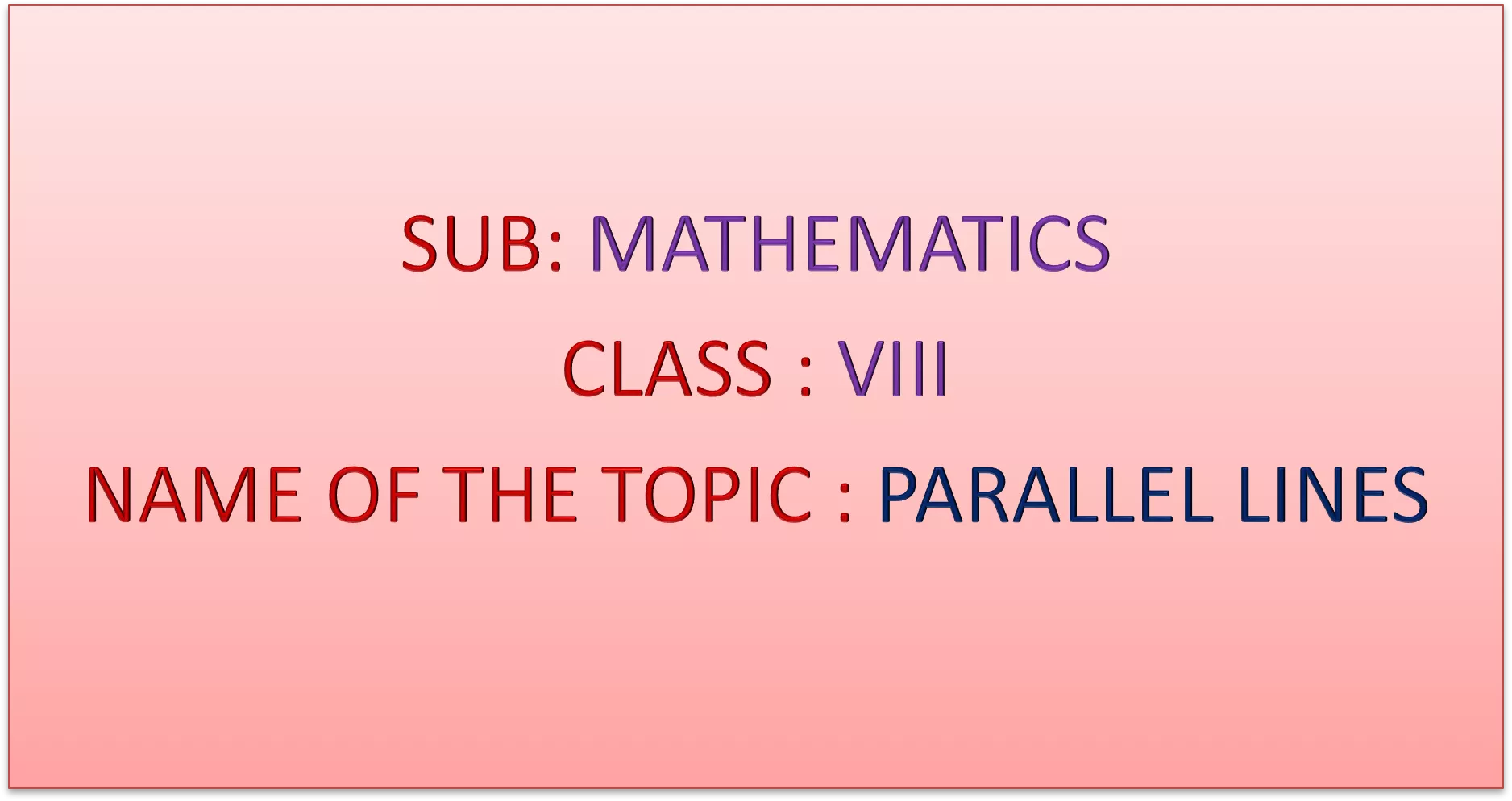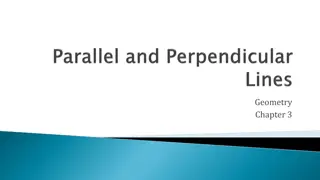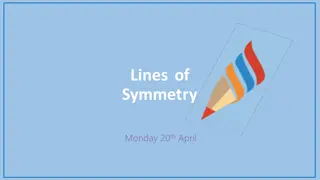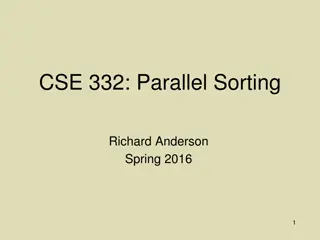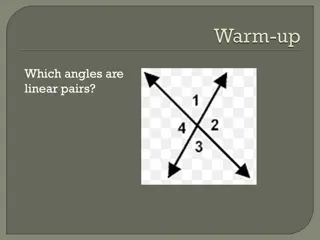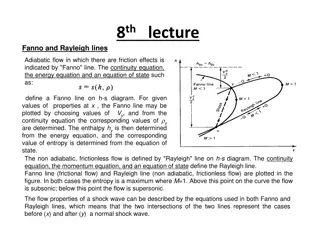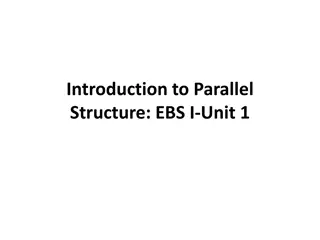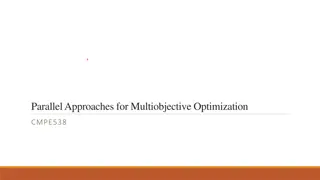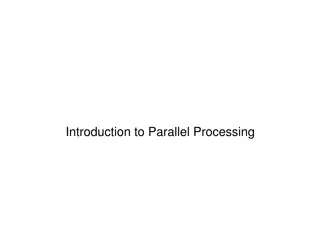Parallel Lines and Their Properties
In this lesson, students will learn about parallel lines and their properties through various examples and explanations. The lesson covers the definition of parallel lines, identifying parallel and non-parallel lines, understanding the concept of transversals, and exploring angles formed by a transversal with two parallel lines. Through clear illustrations and practical examples, students will enhance their understanding of geometric concepts related to parallel lines.
Download Presentation

Please find below an Image/Link to download the presentation.
The content on the website is provided AS IS for your information and personal use only. It may not be sold, licensed, or shared on other websites without obtaining consent from the author.If you encounter any issues during the download, it is possible that the publisher has removed the file from their server.
You are allowed to download the files provided on this website for personal or commercial use, subject to the condition that they are used lawfully. All files are the property of their respective owners.
The content on the website is provided AS IS for your information and personal use only. It may not be sold, licensed, or shared on other websites without obtaining consent from the author.
E N D
Presentation Transcript
PDF CHAPTER LINK https://drive.google.com/open?id=1TyuuzJ69E8 nB4Bhp8XDPXBMKhwrf5IUO Work is Worship
LEARNING OBJECTIVES After this lesson, students will be able to: identify and describe parallel lines. practice various methods of proving that lines are parallel. choose a method of measuring angles to prove lines are parallel. divide a line segment into equal parts as well as in a given ratio internally. Work is Worship
INTRODUCTION Do you know what parallel lines are? You will understand this with the following examples. Every one of you must have seen the pair of railway tracks or a ladder or zebra crossing or opposite edges of your book. What is one common thing among all these? RAILWAY TRACK LADDER BOOK ZEBRA CROSSING Work is Worship
WHAT DO YOU OBSERVE ? The two tracks never meet each other. Also the two sides of the ladder never intersect each other. The lines in a zebra crossing never meet each other. Opposite edges of your book also never intersect each other. Let us take another example which you all are using everyday while solving problems in Mathematics. Yes, that is your commonly used = symbol( equal symbol) The two line segments in this symbol also never intersect each other. SUCH TYPE OF LINES WHICH DO NOT INTERSECT EACH OTHER ,ARE CALLED PARALLEL LINES. Work is Worship
PARALLEL LINES AND NON-PARALLEL LINES NON PARALLEL LINES Lines which are not parallel, are called non parallel or intersecting lines. PARALLEL LINES The lines on the same plane which do not intersect each other even if extended in any direction, are called parallel lines. There is a common point between two non-parallel lines. Example: Adjacent sides of a rectangle . There is no common point between two parallel lines. Example: Opposite sides of a rectangle . Work is Worship
PARALLEL LINES AND THEIR TRANSVERSAL When a line intersects two or more parallel lines at distinct points, then that line is called TRANSVERSAL of the lines. In the figure, line t Intersects line r and s at two distinct points. So, line t is a transversal of line r and s . Symbol used to represent parallel lines: Work is Worship
ANGLES FORMED BY A TRANSVERSAL WITH TWO PARALLEL LINES When a transversal intersects two parallel lines, at each point of intersection four angles will be formed. So , if two parallel lines get intersected by a transversal, eight angles will be formed. In the given figure, s t and r is the transversal. Eight angles formed are named as 1, 2, 3, 4, 5, 6, 7 and 8. Let us consider the details in a tabular form for easy reference. Types of AnglesAngles Interior Angles 3, 4, 5, 6 Exterior Angles 1, 2, 7, 8 Vertically opposite Angles ( 1, 3), ( 2, 4), ( 5, 7), ( 6, 8) Corresponding Angles ( 1, 5), ( 2, 6), ( 3, 7), ( 4, 8) Interior Alternate Angles ( 3, 5), ( 4, 6) Exterior Alternate Angles ( 1, 7), ( 2, 8) Interior Angles on the same side of transversal ( 3, 6), ( 4, 5) Work is Worship
PROPERTIES OF PARALLEL LINES When a transversal intersects two parallel lines The corresponding angles are equal. ( 1= 5), ( 2= 6), ( 3= 7), ( 4= 8) The alternate interior angles are equal. ( 3 = 5), ( 4 = 6) The alternate exterior angles are equal. ( 1= 7), ( 2= 8) The pair of interior angles on the same side of the transversal are supplementary. 3+ 6 = 180 and 4 + 5 = 180 Work is Worship
LETS TRY . Q. In the given figure , a b. If 1 = 55 , find 2, 5 and 8. Answer : 1+ 2 = 180 (linear pair) 2 = 180 - 1 = 180 - 55 = 125 1= 5 (pair of corresponding angles) 5 = 55 2= 8 (alternate exterior angles) 8 = 125 Thus , 2 = 125 , 5 = 55 and 8 = 125 . Work is Worship
SAMPLE QUESTION WITH BREAK UP MARKS Q. In the given figure , a b. If 1 = 55 , find 2, 5 and 8. (3 marks) Answer : 1+ 2 = 180 (linear pair) [0.5] 2 = 180 - 1 = 180 - 55 = 125 [0.5] 1= 5 (pair of corresponding angles) ..[0.5] 5 = 55 .[0.5] 2= 8 (alternate exterior angles) [0.5] 8 = 125 .[0.5] Thus , 2 = 125 , 5 = 55 and 8 = 125 . N.B. If you will not write the reason , as a whole 1 mark will be deducted Work is Worship
CONDITIONS FOR LINES TO BECOME PARALLEL If a transversal cuts a pair of lines in such a way that the angles of any pair of corresponding angles are equal, then the lines are parallel. the angles of any pair of alternate interior (or exterior) angles are equal, then the lines are parallel. The angles of any pair of interior angles on the same side of the transversal are supplementary, then the lines are parallel. Work is Worship
LETS TRY. Q. In the given figure, 1= 2. Show that AD BC. [2 marks] Answer: D C Given that 1= 2 But they forms a pair of 1 2 corresponding angles. [1] A B As corresponding angles are equal, lines are parallel. [0.5] AD BC. [0.5] Work is Worship
Q. In the given figure, 1=135, 2=45 and 3=135, , verify that l m and p q. Give reason. (2 marks) Answer : l m 1=135 and 2=45 1 4 Then 4 = 180 - 45 =135 (linear pair) 2 p 1 = 4 = 135 .(0.5) 3 q l m as p is transversal and one pair of corresponding angles is equal. .(0.5) Again, 1+ 2 = 135 + 45 = 180 ..(0.5) As one pair of interior angles on the same side of transversal is supplementary , the lines are parallel. p q (0.5) N.B. If you will not write the reason, as a whole 0.5 mark will be deducted. Work is Worship
DISTANCE BETWEEN PARALLEL LINES The distance between parallel lines does not change. It is the same every where. s A P t B Q s t AB= PQ Work is Worship
LINES PARALLEL TO A GIVEN LINE Lines, parallel to a given lines in a plane, are parallel to each other. In the given figure, 1 l l m and l n so 1= 2 [corresponding angles 2 m as l m ] 3 n and 1= 3 [corresponding angles as l n ] 1= 2 = 3 and these forms a pair of corresponding angles. l m n Work is Worship
LINES PERPENDICULAR TO A GIVEN LINE Lines, perpendicular to a given line in a plane, are parallel to each other. In the given figure, m n m l and n l so 1= 90 and 2 = 90 1 2 so, 1= 2 = 90 and these forms a pair of corresponding angles. m n l Work is Worship
DIVISION OF A LINE SEGMENT INTO EQUAL PARTS Q. Draw a line segment AB= 6cm and divide it into five equal parts. Ans. Step I : Draw a line segment AB = 6 cm. Step II : At A , draw a ray AC making an angle with AB Step III : At B , draw a ray BD parallel to AP on the opposite side of AB Step IV : Using compass, mark five points on AC at equal distances and five points on BD with the same distances. Step V : Join the points as shown in the figure. The line segment now divided into five equal parts. https://drive.google.com/file/d/1C3HCRKfwOCzjFRPSNksURdHjHn5TkJXJ/ view?usp=drivesdk Work is Worship
DIVISION OF A LINE SEGMENT IN A GIVEN RATIO INTERNALLY Q. Draw a line segment AB= 5.5cm and divide it internally in the ratio 4:5. (4 marks) Ans. Step I : Draw a line segment AB = 5.5 cm. [0.5] Step II : At A , draw a ray AX making an acute angle with AB [0.5] Step III : At B , draw a ray BY parallel to AX on the opposite side of AB [1] Step IV : Using compass, mark four points on AX at equal distances and five points on BY with the same distances. [1] Step V : Join the last points on AX and BY as shown in the figure. [1] The line segment AB now divided in 4:5 ratio internally. Work is Worship
ACTIVITY https://youtu.be/WitF_dWOmNo Work is Worship
ART INEGRATION Using parallel lines, we can design beautiful arts. https://drive.google.com/file/d/1C0-A86KLF1F5NdF3- KoNm3rEEzv5JCNw/view?usp=drivesdk Work is Worship
APPLICATION OF PARALLEL LINES IN TESSELLATION Do you know what is Tessellation ? A tessellation is a simple process of tiling a floor or surface with a definite shape repeated and joined together so that there is no overlapping or gaps. Work is Worship
APPLICATION OF PARALLEL LINES IN TESSELLATION (CONTD.) We can make beautiful TESSELLATIONS using parallel lines. Work is Worship
KEY CONCEPT Parallel lines always remain in the same plane and never intersect each other. The distance between parallel lines is same every where . Lines, parallel to a given line in a plane, are parallel to each other. Lines, perpendicular to a given line in a plane, are parallel to each other. When a transversal intersects two parallel lines the corresponding angles are equal the alternate interior angles are equal the alternate exterior angles are equal the pair of interior angles on the same side of the transversal are supplementary Work is Worship
KEY CONCEPT(CONTD) If a transversal cuts a pair of lines in such a way that the angles of any pair of corresponding angles are equal, then the, lines are parallel the angles of any pair of alternate interior (or exterior) angles are equal, then the lines are parallel. the angles of any pair of interior angles on the same side of the transversal are supplementary, then the lines are parallel. A line segment can be divided into equal parts by constructing parallel lines. A line segment can be divided internally in a given ratio by constructing parallel lines. Work is Worship
MIND MAPPING PROPERTIES OF PARALLEL LINES DISTANCE BETWEEN TWO PARALLEL LINES DOES NOT CHANGE PARALLEL LINES IN THE SAME PLANE LINES PARALLEL TO A GIVEN LINE ARE PARALLEL TO EACH OTHER CONDITION FOR LINES TO BECOME PARALLEL IN THE SAME PLANE LINES PERPENDICULR TO A GIVEN LINE ARE PARALLEL TO EACH OTHER CORRESPONDING ANGLES ARE EQUAL IF A PAIR OF CORRESPONDING ANGLES ARE EQUAL IF A PAIR OF ALTERNATE INTERIOR ( OR EXTERIOR) ANGLES ARE EQUAL ALTRENATE INTERIOR (OR EXTERIOR) ANGLES ARE EQUAL IF A PAIR OF INTERIOR ANGLES ON THE SAME SIDE OF THE TRANSVERSAL ARE SUPPLIMENTARY ANGLES ON THE SAME SIDE OF THE TRANSVERSAL ARE SUPPLIMENTARY Work is Worship








